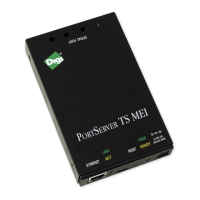Page 134 Configuring Modem Connections 90030500B
A script that tries alternate numbers
The following dialer script uses the “
*
” return code to advance to the next phone
number in the System Table, when a busy signal is encountered.
s1=”M{atdt%n\r} G2”
s2=”[BUSY]* [CONNECT]+ S50 T-”
s3=”P1 G+”
This script exits with:
•
“remote busy” when it receives
a busy signal.
•
“success” when it receives
a connect signal.
• “general failure” when there is a timeout.
If “remote busy” is generated, PortServer II tries the next phone number from the
System Table in the same script. If there are no more phone numbers, either because
all numbers have been tried or there are no alternates, the connection attempt fails.
Note:
You can use the
set user
command to configure a
RemoteBusyDelay
timer. If you do this, the script is executed again when the timer expires.
A script that tries the same number multiple times
You can configure a dialer script that repeats each phone number several times before
advancing to the next number. For example:
s1="M{atdt%n\r} [BUSY]2 [CONNECT]+ s10 T="
s2="P2 R* G1"
When a busy signal is received, state
s2
is entered. The script pauses for two seconds,
then decrements the retry counter. When the retry counter is negative, the script
returns with
“remote busy”
; otherwise it goes to state
s1
and retries the phone
number. If a timeout occurs, the script exits with “remote system down.”
The example above tries each phone number in the User Table twice. The initial retry
count is equal to the retry number defined in a Chat Table entry, or 1 if a Chat Table
entry is not defined. Refer to
set chat
in the
Command Reference Guide
for
information on how to set these values.

